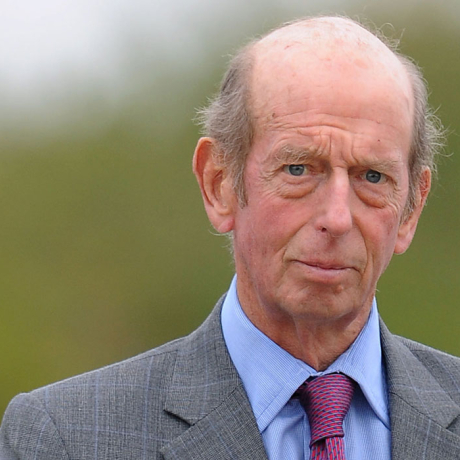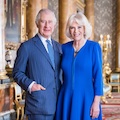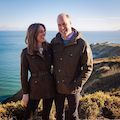About The Duke of Kent
The Duke of Kent is involved with over 140 different charities, organisations and professional bodies which cover a wide range of issues, from commemorating the war dead, to fostering the development of British technology and industry. His Royal Highness undertakes numerous engagements each year in support of these organisations, both in the UK and across the Commonwealth.
War commemoration
The Duke of Kent is passionate about encouraging future generations to remember the sacrifices made by so many during the conflicts of World War I and World War II.
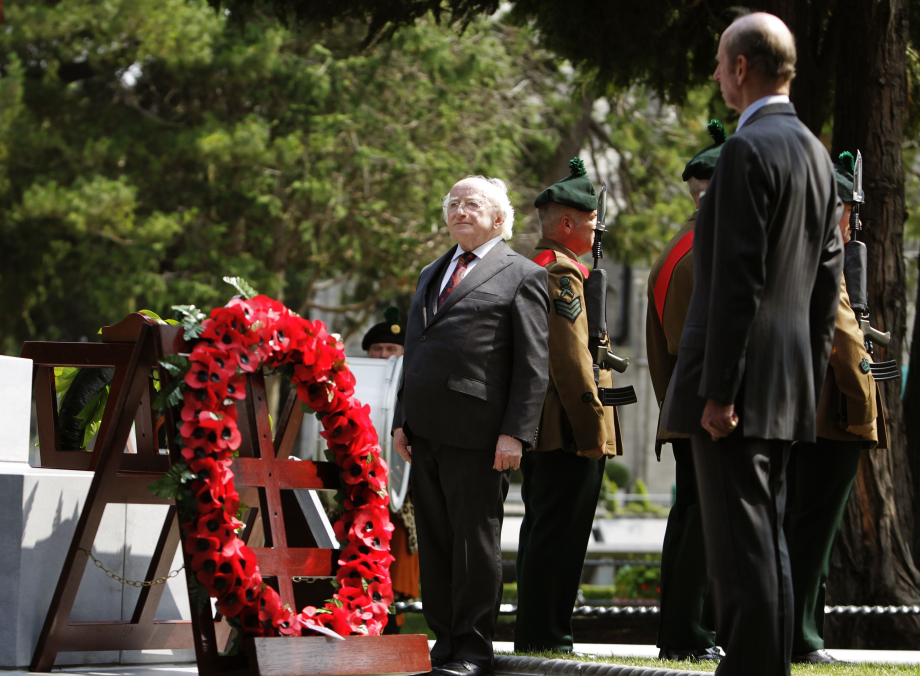
The Duke has been President of the Commonwealth War Graves Commission since 1970, an organisation that commemorates Commonwealth servicemen and women who died in the two world wars, and cares for memorials at 23,000 locations in 154 countries.
The Duke remains closely involved with their work and travels widely to visit the sites.
WWII anniversaries are now an occasion for joint remembrance: an opportunity to pause and reflect on the horrors of war; to mourn and commemorate those who lost or gave their lives; to display our solidarity with those who survived.
WWII anniversaries are now an occasion for joint remembrance: an opportunity to pause and reflect on the horrors of war; to mourn and commemorate those who lost or gave their lives; to display our solidarity with those who survived
The Duke of Kent
In April 2015, The Duke visited Australia and undertook a full programme of Commonwealth War Graves visits. His Royal Highness visited Centennial Park Cemetery and West Terrace Cemetery in Adelaide, and attended a Service at the Shrine of Remembrance, in Melbourne. As part of the trip, he also attended the ANZAC Day services at the Australian War Memorial in Canberra and took part in the ceremony to remember more than 140,000 Australian, New Zealand, British, Irish, Allied and Ottoman servicemen who died during the Gallipoli campaign, in the 100th anniversary year.
In 2014 The Duke of Kent also visited Commonwealth War Graves in Belgium, Ireland and Bulgaria.
In 2018, The Duke of Kent visited Commonwealth War Cemeteries on the former Western Front, including Etaples Military Cemetary, the largest Commonwealth war cemetery in France, and St Etienne au Mont Communal Cemetery, where he paid tribute to the contribution of the ‘Chinese Labour Corps and South African Native Labour Corps’, 168 of whom are buried here.
In 2014 The Duke of Kent also visited Commonwealth War Graves in Belgium, Ireland and Bulgaria.
In 2018, The Duke of Kent visited Commonwealth War Cemeteries on the former Western Front, including Etaples Military, the largest Commonwealth war cemetery in France, and St Etienne au Mont Communal Cemetery, where he paid tribute to the contribution of the ‘Chinese Labour Corps and South African Native Labour Corps’, 168 of whom are buried here.
"As President of the Commonwealth War Graves Commission, it has been my honour to visit war cemeteries and memorials across the globe."
The Duke of Kent
The Duke of Kent has been President of the Board of Trustees for the Imperial War Museum since 1974 in this role he lends his support to exhibitions and keeps informed about the developments for the museum.
Rescue, medicine and social care
The Duke of Kent has been President of the Royal National Lifeboat Institution (RNLI) since 1969, succeeding his parents. The RNLI, as it is commonly known, is a charity providing a 24-hour lifesaving service around the UK and Ireland. The Duke regularly visits lifeboat stations nationwide to meet the dedicated volunteer crews and the fundraisers who support their vital work saving lives at sea.
The Duke has been President of the Stroke Association since 1977, and has helped to promote fundraising for this charity that seeks to educate the public about the risks of strokes, the third most common cause of death in the UK.
In 2010 The Duke of Kent became the first Patron of St Mungo's Broadway, a homelessness charity and housing association in England. The Duke is committed to supporting the organisation which helps men and women with accommodation, advice, health services and skills development, by helping to raise awareness of the problems faced by the homeless. His Royal Highness has visited a number of hostels and seen first-hand how St Mungo's Broadway staff support residents in a compassionate way, focusing on the person's recovery.
Sport
The Duke of Kent is well-known for his involvement with the Wimbledon Championships. As President of the All England Lawn Tennis and Croquet Club since 1969, each summer The Duke attended Wimbledon and presented the winners' trophies to the champions at the end of the tournament. In 2021, His Royal Highness stepped down as President after over five decades in the role.
His Royal Highness is also Patron of a number of other sporting bodies, including the Ski Club of Great Britain; Kent County Cricket Club; and Royal West Norfolk Golf Club. He is President-in-Chief of The British Racing Drivers' Club.
Innovation, business and engineering
As Vice Chairman of the Overseas Trade Board and later British Trade International (now known as UK Trade and Investment) from 1976 to 2001, The Duke undertook over 60 overseas trips to promote British trade and exports, including to Europe, Japan, Australia and the Middle East. He was the first member of the Royal Family to make an official visit to China.
Following his many years in the role, The Duke of Kent still retains an interest in British business at home and overseas. A number of the organisations with which The Duke is affiliated reflect his personal interest in technology and industry, including the Royal Institution, the Royal Academy of Engineering and the Royal Society whose Summer Exhibition he visits each year to view a number of the latest developments in science.
The Duke has been Chancellor of The University of Surrey since 1976. The University, now rated as one of the top universities in the UK, has long and successful record of promoting scientific research and innovation, leading to several successful commercial ventures.
Following his many years in the role, The Duke of Kent still retains an interest in British business at home and overseas. A number of the organisations with which The Duke is affiliated reflect his personal interest in technology and industry, including the Royal Institution, the Royal Academy of Engineering and the Royal Society whose Summer Exhibition he visits each year to view a number of the latest developments in science.
Music
The Duke's personal passion for music is reflected in his support for many musical organisations, from the London Philharmonic Orchestra and Opera North, to the Trinity Laban Conservatoire of Music and Dance in Greenwich, one of the UK's leading music colleges, and to regional festivals such as those at Newbury and King's Lynn.
Rebuilding relations between the UK and Germany
The Duke of Kent has for decades been active in fostering British-German relations and is Patron of the British German Association and the Dresden Trust, which both share this underlying aim.
On 14 February 2015, The Duke of Kent was awarded The Dresden International Peace Prize for his contribution to the reconciliation of Great Britain and Germany.
In 2004 the Dresden Trust presented the gold cross steeple which sits on top of the Frauenkirche Cathedral, as a gift from the British people to Dresden. The cathedral in Dresden, Saxony was severely damaged by a bombing raid by the British in 1945, in response to the Germans bombing London. Both Britain and Germany suffered incredible losses during the Second World War air raids. The reconstruction of the Frauenkirche cathedral, and the installation of the cross and orb steeple, was a significant moment in the 60 year reconciliation process between the two countries, following the war. The British goldsmith who made the cross and orb is the son of a RAF airman who took part in the bombing raid on Dresden.
More recently, The Duke of Kent attended the ceremony of the 10th Dresden Peace Prize to present the award sculpture to Kim Phuc Phan Thi. Find out more.
Biography
The Duke of Kent was born Prince Edward on 9 October 1935 at the family's London home, 3 Belgrave Square. He was baptised as Edward George Nicholas Paul Patrick. He is older brother to Prince Michael of Kent and Princess Alexandra, and is first cousin to both Queen Elizabeth II and The Duke of Edinburgh.
His father was Prince George, Duke of Kent, the younger brother of King George VI (The Queen's father) and King Edward VIII. His mother, Princess Marina, was the daughter of Prince Nicholas of Greece.
In 1942 his father Prince George, then Duke of Kent, died in a wartime flying accident near Caithness in Scotland while on active service. The title Duke of Kent then passed to the present Duke.
The Duke went to school at Ludgrove preparatory school in Berkshire (which later Prince Harry also attended) and afterwards went on to study at Eton, where he enjoyed rowing. He then went on to study at Le Rosey in Switzerland where he captained his regimental ski team in the Army championships.
When his uncle King George VI died in 1952, The Duke of Kent, aged 16, walked in the procession behind The King's coffin during the State Funeral. A year later in 1953 he attended the Coronation of his cousin, Queen Elizabeth II. During the Coronation Service he paid homage to Queen Elizabeth, making a pledge of loyalty to the Sovereign, after Prince Philip and Prince Henry, Duke of Gloucester.
At the age of 18, The Duke of Kent joined The Royal Military Academy Sandhurst in Surrey, where he won the Sir James Moncrieff Grierson prize for foreign languages and qualified as an interpreter of French.
In 1961 The Duke of Kent became engaged to Miss Katharine Worsley and they married in York Minster on 8 June. The couple had met while The Duke was based at Catterick Camp Army base in Yorkshire.
The Duke and Duchess of Kent have three children: George, Earl of St Andrews, born on 28 June 1962; Lady Helen Taylor, born on 18 July 1964 and Lord Nicholas Windsor, born on 25 July 1970. None of their children carry out official Royal duties. They have ten grandchildren. The Duke and Duchess live at Wren House Kensington Palace, and in Oxfordshire.
Military service
The Duke of Kent served in the Armed Forces in the UK and overseas for 21 years:
1955: The Duke graduated from Sandhurst as a Second Lieutenant in the Royal Scots Greys.
1962-1963: The Duke undertook a regimental tour in Hong Kong
1966: The Duke attended the Army staff course and then served on the staff in Eastern Command.
1970: The Duke commanded a squadron of his regiment serving in Cyprus as part of the United Nations force.
1976: The Duke retired from the Army with the rank of Lieutenant-Colonel.
1993: The Duke was promoted to Field Marshal.
The Duke retains close links to the Army today and he holds a number of senior appointments and visits his regiments on a regular basis. His Royal Highness made a number of visits to both Iraq and Afghanistan to visit his regiments when they were engaged in combat operations in those regions.
Supporting the Monarch
A regular presence at events such as Trooping the Colour and the National Service of Remembrance at the Cenotaph, The Duke of Kent supported The Queen throughout her reign. His Royal Highness undertook a number of overseas visits on behalf of Her Majesty over the course of her reign.
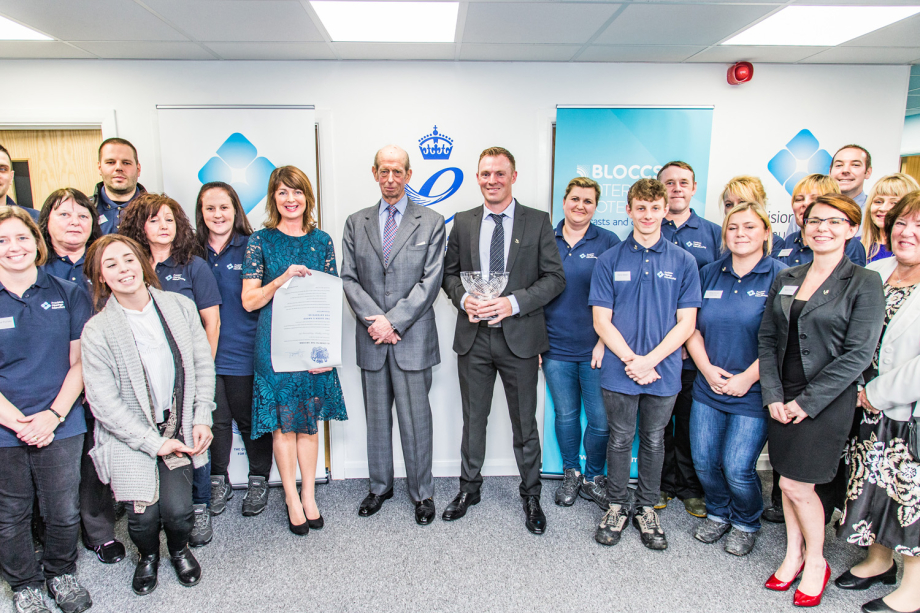
The Duke represented The Queen at the independence celebrations in Sierra Leone (1961), Uganda (1962), Guyana (1966) and The Gambia (1965).
His Royal Highness returned to Uganda in October 2012 as part of the celebration of Queen Elizabeth’s Diamond Jubilee, when members of the Royal Family travelled to Commonwealth nations on Her Majesty's behalf to mark The Queen's 60 year reign. The visit also marked the 50th anniversary of Uganda's full independence from the United Kingdom. The Duke's visit represented the continuity of his interest in this African nation and supported Her Majesty in her role as Head of the Commonwealth.
The Duke supported Queen Elizabeth II at Her Majesty's Birthday Parade over many years. For most of Queen Elizabeth's reign The Duke would ride in the procession behind Her Majesty during Trooping the Colour. In 2021 The Duke joined Queen Elizabeth on the Royal Dais at Windsor Castle, and for the Platinum Jubilee, His Royal Highness joined Her Majesty on the balcony of Buckingham Palace for a march past of Armed Forces personnel. The Duke also regularly attends Garden Parties, meeting thousands who have contributed to society, alongside The King and other members of the Royal Family.
Filter results by:
1st Battalion, The Rifles
Website: https://www.army.mod.uk
Unit of the British Army.
Region: UK (England)
Members of the Royal Family:
The Duke of Kent, Royal Colonel
Admiral Ramsay Museum
To educate people about the two great naval operations which Admiral Ramsay led: The Dunkirk Evacuation and the Normandy Landings.
To educate people about the life and career of Admiral Ramsay.
To educate people about World War 2 more widely.
Region: UK-wide
Members of the Royal Family:
The Duke of Kent, Royal Patron
Airlander Club
.
Region: UK (England)
Members of the Royal Family:
The Duke of Kent, Honorary President of the Airlander Club
Anglo-Jordanian Society
Organisation promoting cultural and social relations between Britain and Jordan.
Region: UK-wide
Members of the Royal Family:
The Duke of Kent, Joint Patrons
The Duchess of Kent, Joint Patrons
Anmer Club
Website: https://www.anmerclub.co.uk
Local social club in Norfolk.
Region: UK (England)
Members of the Royal Family:
The Duke of Kent, President
Army
Website: https://www.army.mod.uk
Terrestrial service of the British Armed Forces.
Region: UK-wide
Members of the Royal Family:
The Duke of Kent, Field Marshal
The Duchess of Kent, Honorary Major General
The King, Field Marshal
Army and Navy Club
Website: https://www.armynavyclub.co.uk
Private members' club.
Region: UK (England)
Members of the Royal Family:
Queen Elizabeth II, Patron
The Duke of Kent, President
Association of Men of Kent and Kentish Men
Website: https://www.menofkentlynsted.org.uk
Local society intended to foster interest in the heritage of the county of Kent.
Region: UK (England)
Members of the Royal Family:
The Duke of Kent, Patron
Bal Polski
The Bal brings together the Polish community in the UK and others with an interest in and love of Poland.
Region: Rest of world
Members of the Royal Family:
The Duke of Kent, Patron
Band of Brothers
Amateur Kent cricket club.
Region: UK (England)
Members of the Royal Family:
The Duke of Kent, Honorary Life Member

